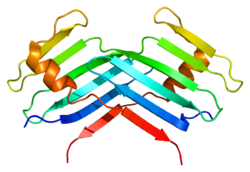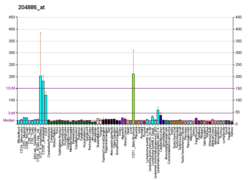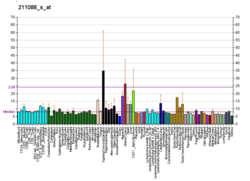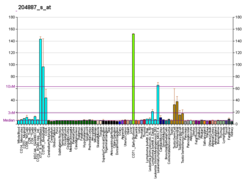PLK4
PLK4(polo like kinase 4)は、ヒトではPLK4遺伝子によってコードされる酵素(プロテインキナーゼ)である[5]。線虫Caenorhabditis elegansのホモログはZYG-1と呼ばれる[6]。
機能
[編集]PLK4はPoloファミリーのセリン/スレオニンキナーゼであり、中心小体に局在している。中心小体は、中心体に存在する微小管を基盤とした構造体である。このタンパク質は、細胞周期中での中心小体の複製を調節している[5]。PLK4の過剰発現は中心体の増幅をもたらし、PLK4のノックダウンは中心体の喪失をもたらす[7][8]。
構造
[編集]PLK4には、N末端のキナーゼドメイン(12–284番残基)とC末端の局在ドメイン(596–898番残基)が含まれている[9]。他のPolo様キナーゼにはC末端に2つのPolo boxドメイン(PBD)が含まれているが、PLK4にはさらに3つ目のPBDが存在し、これらっはオリゴマー化や標的化を促進するとともに、トランス自己リン酸化を促進することで中心体の複製が各細胞周期に一度だけ起こるよう制限している[9]。
がんの薬剤標的として
[編集]PLK4の酵素活性の阻害剤は、がんの治療薬としての可能性を有している[10][11]。PLK4阻害剤R1530は、有糸分裂チェックポイントキナーゼBubR1をダウンレギュレーションして多倍体化をもたらし、がん細胞を不安定にすることで化学療法に対する感受性を高める。正常な細胞はR1530の多倍体化誘導作用に対しては抵抗性を持つ[12]。
他のPLK4阻害剤CFI-400945は、乳がんや卵巣がんの動物モデルにおいて効果が示されている[13][14]。
また他のPLK4阻害剤セントリノン(centrinone)は、ヒトやその他の脊椎動物の細胞種において中心小体の枯渇をもたらし、細胞周期がG1期でp53依存的に停止することが報告されている[15]。ケミカルジェネティクスアプローチによるPLK4の制御によって、このp53依存的な細胞周期の停止は検証されている[16]。
PLK4は悪性ラブドイド腫瘍、髄芽腫、そしておそらく脳のその他の胎児性腫瘍における治療標的としても同定されている[17][18][19][20]。
相互作用と基質
[編集]PLK4の基質としては、STIL、GCP6[21]、HAND1[22][23]、ECT2[24]、FBXW5[25]、そしてPLK4自身(自己リン酸化)が記載されている、PLK4の自己リン酸化は、ユビキチン化とその後のプロテアソームによる分解を引き起こす[26][27]。
PLK4はストラティフィンと相互作用することが示されている[28]。
出典
[編集]- ^ a b c GRCh38: Ensembl release 89: ENSG00000142731 - Ensembl, May 2017
- ^ a b c GRCm38: Ensembl release 89: ENSMUSG00000025758 - Ensembl, May 2017
- ^ Human PubMed Reference:
- ^ Mouse PubMed Reference:
- ^ a b “PLK4 polo like kinase 4 [Homo sapiens (human) - Gene - NCBI]”. www.ncbi.nlm.nih.gov. 2024年10月20日閲覧。
- ^ “Structure of the C. elegans ZYG-1 cryptic polo box suggests a conserved mechanism for centriolar docking of Plk4 kinases”. Structure 22 (8): 1090–1104. (August 2014). doi:10.1016/j.str.2014.05.009. PMC 4126857. PMID 24980795.
- ^ “Oncogene-like induction of cellular invasion from centrosome amplification”. Nature 510 (7503): 167–71. (June 2014). Bibcode: 2014Natur.510..167G. doi:10.1038/nature13277. PMC 4061398. PMID 24739973.
- ^ “The Polo kinase Plk4 functions in centriole duplication”. Nature Cell Biology 7 (11): 1140–6. (November 2005). doi:10.1038/ncb1320. PMID 16244668.
- ^ a b “The structure of the plk4 cryptic polo box reveals two tandem polo boxes required for centriole duplication”. Structure 20 (11): 1905–17. (November 2012). doi:10.1016/j.str.2012.08.025. PMC 3496063. PMID 23000383.
- ^ “Evaluation of Protein Kinase Inhibitors with PLK4 Cross-Over Potential in a Pre-Clinical Model of Cancer”. International Journal of Molecular Sciences 20 (9): 2112. (April 2019). doi:10.3390/ijms20092112. PMC 6540285. PMID 31035676.
- ^ Mason, Jacqueline; Wei, Sam; Luo, Xunyi; Nadeem, Vincent; Kiarash, Reza; Huang, Ping; Awrey, Don; Leung, Genie et al. (2011-04-15). “Abstract LB-215: Inhibition of Polo-like kinase 4 as an anti-cancer strategy” (英語). Cancer Research 71 (8_Supplement): LB–215–LB-215. doi:10.1158/1538-7445.AM2011-LB-215. ISSN 0008-5472.
- ^ “Small-molecule inducer of cancer cell polyploidy promotes apoptosis or senescence: Implications for therapy”. Cell Cycle 9 (16): 3364–75. (August 2010). doi:10.4161/cc.9.16.12732. PMID 20814247.
- ^ “Experimental drug shows promise in treating breast, ovarian cancer”. News. Canadian Broadcasting Corporation (2013年6月18日). 2024年10月21日閲覧。
- ^ “Discovery of orally active anticancer candidate CFI-400945 derived from biologically promising spirooxindoles: success and challenges”. European Journal of Medicinal Chemistry 95: 35–40. (May 2015). doi:10.1016/j.ejmech.2015.03.020. PMID 25791677.
- ^ “Cell biology. Reversible centriole depletion with an inhibitor of Polo-like kinase 4”. Science 348 (6239): 1155–60. (June 2015). doi:10.1126/science.aaa5111. PMC 4764081. PMID 25931445.
- ^ “p53 protects against genome instability following centriole duplication failure”. The Journal of Cell Biology 210 (1): 63–77. (July 2015). doi:10.1083/jcb.201502089. PMC 4494000. PMID 26150389.
- ^ “A functional screening of the kinome identifies the Polo-like kinase 4 as a potential therapeutic target for malignant rhabdoid tumors, and possibly, other embryonal tumors of the brain”. Pediatric Blood & Cancer 64 (11): e26551. (November 2017). doi:10.1002/pbc.26551. PMID 28398638.
- ^ “Inhibition of polo-like kinase 4 (PLK4): a new therapeutic option for rhabdoid tumors and pediatric medulloblastoma”. Oncotarget 8 (67): 111190–111212. (December 2017). doi:10.18632/oncotarget.22704. PMC 5762315. PMID 29340047.
- ^ “Polo-Like Kinase 4 (PLK4) Is Overexpressed in Central Nervous System Neuroblastoma (CNS-NB)”. Bioengineering 5 (4): 96. (November 2018). doi:10.3390/bioengineering5040096. PMC 6315664. PMID 30400339.
- ^ “Evaluation of Protein Kinase Inhibitors with PLK4 Cross-Over Potential in a Pre-Clinical Model of Cancer”. International Journal of Molecular Sciences 20 (9): 2112. (April 2019). doi:10.3390/ijms20092112. PMC 6540285. PMID 31035676.
- ^ “GCP6 is a substrate of Plk4 and required for centriole duplication”. Journal of Cell Science 125 (Pt 2): 486–96. (January 2012). doi:10.1242/jcs.093930. PMID 22302995.
- ^ “Nucleolar release of Hand1 acts as a molecular switch to determine cell fate”. Nature Cell Biology 9 (10): 1131–41. (October 2007). doi:10.1038/ncb1633. PMID 17891141.
- ^ “Late mitotic failure in mice lacking Sak, a polo-like kinase”. Current Biology 11 (6): 441–6. (March 2001). Bibcode: 2001CBio...11..441H. doi:10.1016/s0960-9822(01)00117-8. PMID 11301255.
- ^ “Plk4 is required for cytokinesis and maintenance of chromosomal stability”. Proceedings of the National Academy of Sciences of the United States of America 107 (15): 6888–93. (April 2010). Bibcode: 2010PNAS..107.6888R. doi:10.1073/pnas.0910941107. PMC 2872425. PMID 20348415.
- ^ “The SCF-FBXW5 E3-ubiquitin ligase is regulated by PLK4 and targets HsSAS-6 to control centrosome duplication”. Nature Cell Biology 13 (8): 1004–9. (July 2011). doi:10.1038/ncb2282. PMID 21725316.
- ^ “Regulation of autophosphorylation controls PLK4 self-destruction and centriole number”. Current Biology 23 (22): 2245–54. (November 2013). Bibcode: 2013CBio...23.2245C. doi:10.1016/j.cub.2013.09.037. hdl:10400.7/833. PMID 24184099.
- ^ “Plk4 trans-autophosphorylation regulates centriole number by controlling betaTrCP-mediated degradation”. Journal of Cell Science 123 (Pt 13): 2163–9. (July 2010). doi:10.1242/jcs.068502. PMID 20516151.
- ^ “Towards a proteome-scale map of the human protein-protein interaction network”. Nature 437 (7062): 1173–8. (October 2005). Bibcode: 2005Natur.437.1173R. doi:10.1038/nature04209. PMID 16189514.
関連文献
[編集]- “Plk4-induced centriole biogenesis in human cells”. Developmental Cell 13 (2): 190–202. (August 2007). doi:10.1016/j.devcel.2007.07.002. PMID 17681131.
- “SAK/PLK4 is required for centriole duplication and flagella development”. Current Biology 15 (24): 2199–207. (December 2005). Bibcode: 2005CBio...15.2199B. doi:10.1016/j.cub.2005.11.042. PMID 16326102.
- “The Polo kinase Plk4 functions in centriole duplication”. Nature Cell Biology 7 (11): 1140–6. (November 2005). doi:10.1038/ncb1320. PMID 16244668.
- “Towards a proteome-scale map of the human protein-protein interaction network”. Nature 437 (7062): 1173–8. (October 2005). Bibcode: 2005Natur.437.1173R. doi:10.1038/nature04209. PMID 16189514.
- “SAK, a new polo-like kinase, is transcriptionally repressed by p53 and induces apoptosis upon RNAi silencing”. Neoplasia 7 (4): 312–23. (April 2005). doi:10.1593/neo.04325. PMC 1501148. PMID 15967108.
- “High-throughput mapping of a dynamic signaling network in mammalian cells”. Science 307 (5715): 1621–5. (March 2005). Bibcode: 2005Sci...307.1621B. doi:10.1126/science.1105776. PMID 15761153.
- “Sequence comparison of human and mouse genes reveals a homologous block structure in the promoter regions”. Genome Research 14 (9): 1711–8. (September 2004). doi:10.1101/gr.2435604. PMC 515316. PMID 15342556.
- “Comparative expression of the mitotic regulators SAK and PLK in colorectal cancer”. Annals of Surgical Oncology 8 (9): 729–40. (October 2001). doi:10.1007/s10434-001-0729-6. PMID 11597015.
- “Sak serine-threonine kinase acts as an effector of Tec tyrosine kinase”. The Journal of Biological Chemistry 276 (42): 39012–20. (October 2001). doi:10.1074/jbc.M106249200. PMID 11489907.
- “Sak kinase gene structure and transcriptional regulation”. Gene 241 (1): 65–73. (January 2000). doi:10.1016/S0378-1119(99)00467-9. PMID 10607900.
- “Identification of 21 novel human protein kinases, including 3 members of a family related to the cell cycle regulator nimA of Aspergillus nidulans”. Cell Growth & Differentiation 4 (10): 821–30. (October 1993). PMID 8274451.








